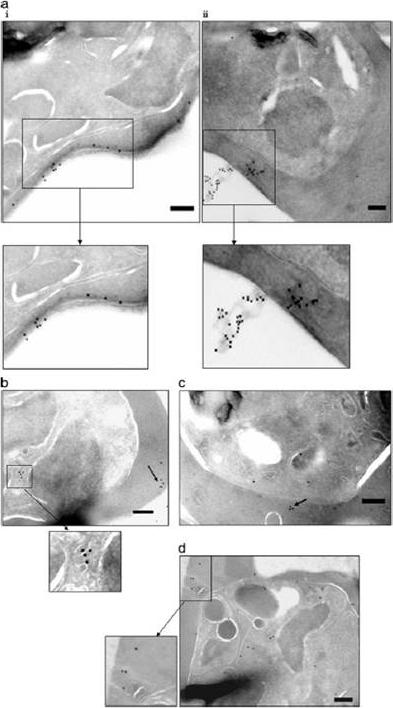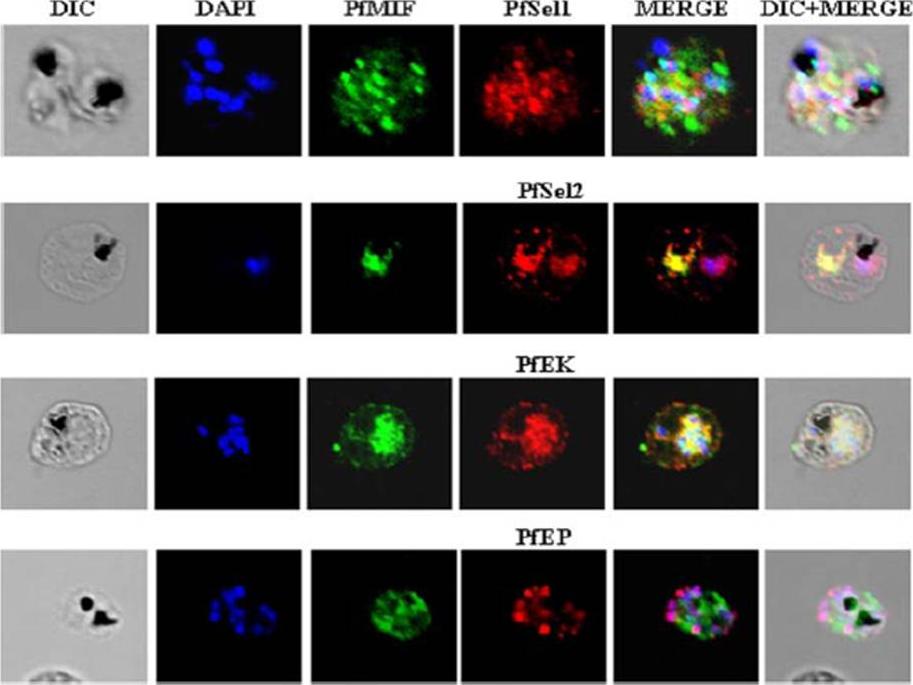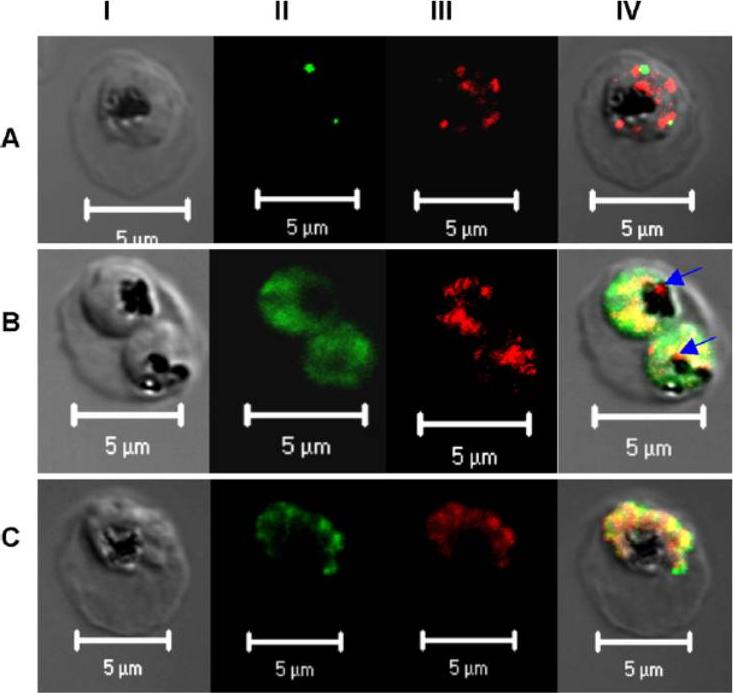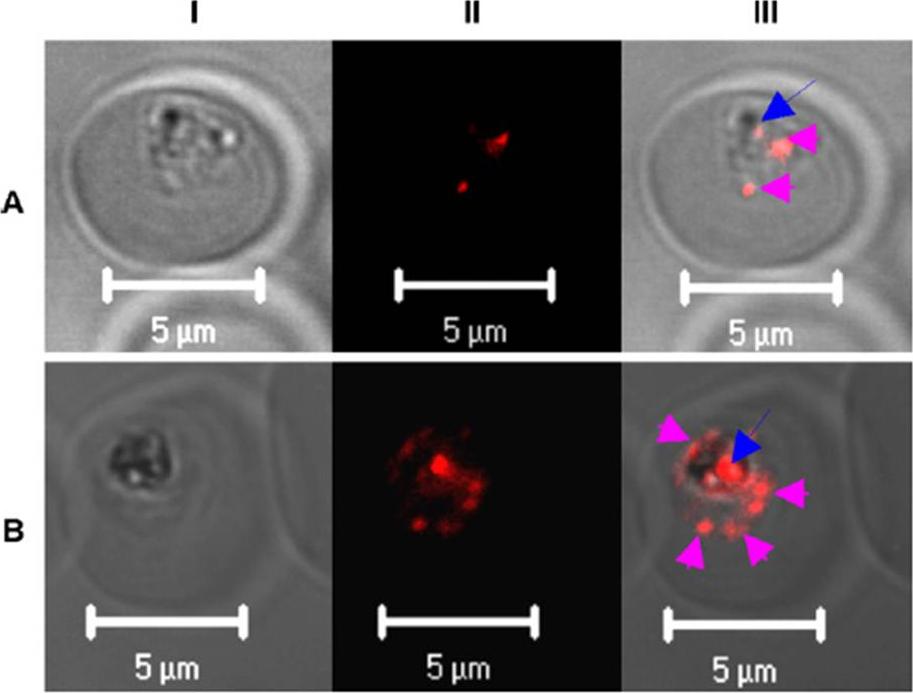PF3D7_1113100 protein tyrosine phosphatase (PRL)
Disruptability [+]
| Species | Disruptability | Reference | Submitter | |
|---|---|---|---|---|
| P. falciparum 3D7 |
Refractory |
USF piggyBac screen (Insert. mut.) | USF PiggyBac Screen | |
| P. berghei ANKA |
Refractory |
RMgm-1061 | Imported from RMgmDB | |
Mutant phenotypes [+]
None reported yet. Please press the '+' button above to add one.Imaging data (from Malaria Metabolic Pathways)

Ultrathin sections of P. falciparum-infected erythrocytes (at late trophozoite/schizont stages) were labeled with specific sera (against the four selected proteins) and gold-conjugated secondary antibody. Localization is depicted as black dots (of gold particles) for PfSEL1 (PFB0190c) - (a, i and ii), PfSEL2 = Hrd3 (b), PfEK (c), and PfEP (d). Enlarged panels and arrows show detailed images of the intracellular staining pattern. Scale bar, 250 nm. PfSEL1 showed a secreted/ extra-cellular staining pattern, localizing in the iRBC cytosol close to the erythrocyte plasma membrane. The gold particle staining showed the protein coating the surface of the iRBC and also being released out in the extra-cellular milieu. PfSEL2 (seen as dots coating vesicle-like structures) and PfEK also showed localization close to iRBC plasma membrane while being exported out of the infected red cells (b and c). PfEP localized in the extensive membranous network of the parasite from where it seemed to be trafficked to the iRBC cytosol and plasma membrane (d). Singh M, Mukherjee P, Narayanasamy K, Arora R, Sen SD, Gupta S, Natarajan K, Malhotra P. Proteome analysis of Plasmodium falciparum extracellular secretory antigens at asexual blood stages reveals a cohort of proteins with possible roles in immune modulation and signaling. Mol Cell Proteomics. 2009 8(9):2102-18.
See original on MMP
Indirect immunofluorescence assay and confocal microscopy to localize the selected excretory-secretory antigens by coimmunostaining of P. falciparum-infected erythrocytes. Air-dried infected erythrocytes were incubated with mouse antibodies specific to the selected proteins at 1:100 dilution (column 4; red). Rabbit aPfMIF antibody was used as a co-localization marker (column 3; green). The parasite nuclei were stained with 4’,6-diamidino-2-phenylindole (DAPI) (column 2; blue). Columns 1, 5, and 6 show a differential interference contrast (DIC) image, merged image, and differential interference contrast with merged image, respectively. Images showed punctate vesicle-like staining of the infected RBCs with antibodies to PfSEL1 (PFB0190c), PfSEL2 (Hrd3), PfEKand PfEP. PfEK also showing specific rimlike staining of the plasma membrane of the infected RBC. PfMIF is exported via the Maurer clefts to the extracellular medium after schizont rupture. A partial co-localization of PfMIF was seen with each of the four proteins, suggesting a distinct pathway for the release of these ESAs.Singh M, Mukherjee P, Narayanasamy K, Arora R, Sen SD, Gupta S, Natarajan K, Malhotra P. Proteome analysis of Plasmodium falciparum extracellular secretory antigens at asexual blood stages reveals a cohort of proteins with possible roles in immune modulation and signaling. Mol Cell Proteomics. 2009 8(9):2102-18.
See original on MMP
Subcellular localization of PfPRL. Micrographs represent the co-staining profiles of PfPRL with the Golgi marker PfErd2 (A), the ER marker PfBip (B), and the rhoptry/micronemal protein PfAMA-1 (C). Synchronous 3D7 parasite cultures were probed with purified rabbit anti-PfPRL in combination with antibodies to the compartmental markers. Binding of primary antibodies was detected using Alexa-Fluor 488 conjugated antibodies (organellar markers) and Alexa-Fluor 555-conjugated anti-rabbit IgG (PfPRL). Panel I is differential interference contrast image, panel II is fluorescence due to Alexa-Fluor 488 (green), panel III fluorescence due to Alexa-Fluor 555 (red), while panel IV is a merge of the first three panels. Yellow spots indicate overlap between PfPRL and the respective organellar marker, while blue arrows indicate food PfPRL-associated sites in the digestive vacuole.Pendyala PR, Ayong L, Eatrides J, Schreiber M, Pham C, Chakrabarti R, Fidock DA, Allen CM, Chakrabarti D. Characterization of a PRL protein tyrosine phosphatase from Plasmodium falciparum. Mol Biochem Parasitol. 2008 158(1):1-10.
See original on MMP
Immunolocalization of PfPRL in P. falciparum infected erythrocytes. The images represent the distribution patterns of PfPRL in P. falciparum intraerythrocytic stages. Synchronous 3D7 parasite cultures were probed with affinity purified rabbit anti-PfPRL followed by incubation with Alexa-Fluor 555-conjugated anti-rabbit IgG. (A) Two cytoplasmic foci (red arrowheads) and a single food vacuole-associated site (blue arrow) of anti-PfPRL reactivity are observed in mid-trophozoite stage parasites. (B) Schizont stage parasite showing increase in number of PfPRL-associted puncta during parasite development. Panel I is differential interference contrast image, panel II is fluorescence due to Alexa-Fluor 555 (red), and panel III is a merge of the first two panels.Pendyala PR, Ayong L, Eatrides J, Schreiber M, Pham C, Chakrabarti R, Fidock DA, Allen CM, Chakrabarti D. Characterization of a PRL protein tyrosinephosphatase from Plasmodium falciparum. Mol Biochem Parasitol. 2008 158(1):1-10. PMID: 18096253
See original on MMPMore information
| PlasmoDB | PF3D7_1113100 |
| GeneDB | PF3D7_1113100 |
| Malaria Metabolic Pathways | Localisation images Pathways mapped to |
| Previous ID(s) | PF11_0139 |
| Orthologs | PBANKA_0934500 , PCHAS_0909800 , PKNH_0910700 , PVP01_0913900 , PVX_091305 , PY17X_0936500 |
| Google Scholar | Search for all mentions of this gene |